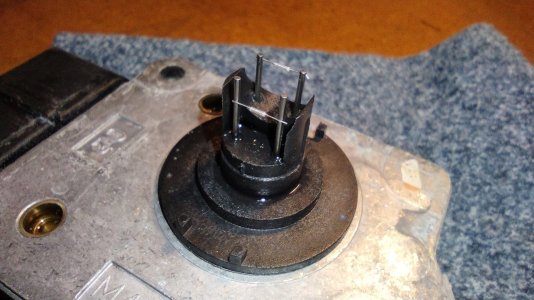Pipe down everyone, class is now in session!

The MAF sensor tells the PCM how much air enters the engine. It uses this data to determine how much fuel to inject, and also is able to calculate the cylinder pressures and determine the appropriate amount of spark advance.
Once the combustion cycle completes, the oxygen in the exhaust gases is measured by the O2 sensors. Under normal conditions the car runs at "stoich" or the perfect air:fuel ratio to ensure complete combustion of all the fuel and oxygen in the air, which is 14.08 parts fuel to air (for E10).
However...........
The car doesn't run at 14.08:1 all the time. It actually switches from slightly lean to slightly rich every couple seconds, centered around perfect stoich.
The two fuel trims - short term and long term - refer to different things.
Short term trim refers to commanded lambda. Long term is a correction factor at a given mass of air.
Lambda refers to a linear scalar of AFR that is independent of fuel type. Lambda 1 is always stoich. Lambda under 1 is rich, and over 1 is lean. E10 stoich is 14.08:1. E0 is 14.64. It's easy to convert lambda to AFR as long as you know the fuel type (stoich) - .85 lambda with E10 is about 12:1.
The STFT, when logged, will show the switching of the fuel system around lambda 1. If you log STFT most of the time it'll be switching between .98 and 1.02 or so. This is assuming all is perfect with the car.
HOWEVER it only does this when it's in "closed loop" - O2 feedback mode. Open loop is where the PCM is only using the MAF sensor. The car runs in closed loop all the time except just after it the engine has started or if you're getting on the throttle. Closed loop means the car is watching the actual mixture relative to the commanded mixture. It's always using the MAF to determine fueling, but based on what it sees (via the O2s) it adjusts fuel delivery slightly, and that adjustment is in the fuel trims.
The LTFTs are a correction factor. So if STFT shows lambda and LTFT is a correction factor, that means that an LTFT over 1 increases fuel delivery (enrich the mixture) but STFT/lambda over 1 is a leaner mixture. This can be confusing!
If the car wants to see a lambda of 1 on the O2s, but if it commands a lambda (STFT) of 1 and observes a lean condition on the O2s, it will slowly enrich the mixture until it sees a lambda of 1. If it has to command a lambda of .9 to read an actual lambda of 1, that would mean it needs to enrich the mixture 10% over spec (e.g. you are running lean - a common symptom of a vacuum leak or dirty MAF).
The PCM continually observes STFTs and averages out how far off-center they are throughout the driving range, and stores this as the LTFT. So if you were 10% lean at idle, but 5% lean while cruising at 40 MPH, the LTFT would be 10% at a low airflow reading and 5% at a slightly higher airflow. This is a part of the adaptive learning routines in the PCM. The LTFT is stored in volatile memory in the PCM. Meaning it gets wiped out if you yank the battery.
You can tell if the MAF sensor and O2s agree with one another by looking for the total fuel correction while running in closed loop. Closed loop means the car wants to maintain a perfect 1.00 lambda by swithching from .98 to 1.02. So if you're seeing STFTs doing that and your LTFTs are also .98 to 1.02, then you know you're only a couple percent away from perfect spec as measured by the factory. If you were seeing .98 and 1.02 on your STFT but you had 1.1 on your LTFT, that would mean the PCM is adding 10% fuel due to a lean condition - possibly caused by the MAF.
In Neuro's case, his STFTs look fine, but his LTFTs show 1.04 and 1.06-08 on the other bank. It's pretty uniform across the operating range, so I'm attributing a portion of that to injector flow differences between banks. It is possible a couple percent of that could be MAF sensor related, but a bad MAF usually manifests in the worst ways as bogus or erratic readings. A replacement might bring it closer to spec, but it still wouldn't be perfect. Only way to dial it in that close would be to have the car tuned for the unique characteristics of the MAF on the car.
Because the PCM is also programmed with the base AFR of the fuel (back in the 90s E0 was more common), our cars think lambda 1 is 14.64:1 AFR. Because E10 is more prevalent now, it's entirely possible the 4% enrichment seen in his LTFTs is just a result of that difference. E10 burns 4% more fuel than E0 does at stoich, after all.




